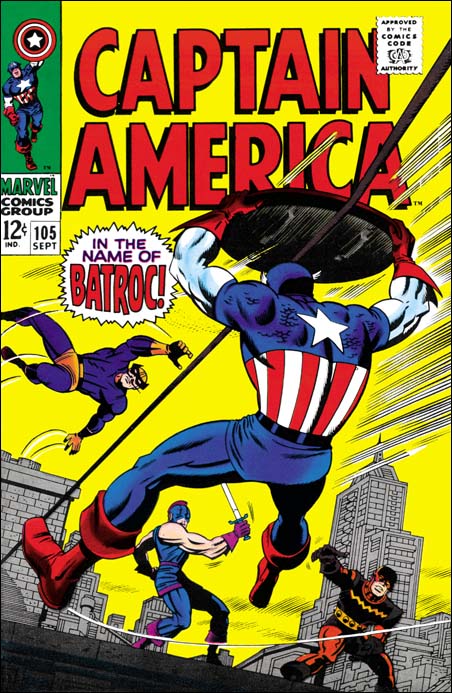
Captain America #105 (September 1968) by Jack Kirby, John Romita and Dan Adkins?
Usually I confine myself in this blog to the time of Simon and Kirby’s collaboration. Occasionally I venture outside that period, for example in a series of posts I once did on Kirby margin notes. Generally I leave the Kirby’s more recent work to the Jack Kirby Blog where Bob does such a great job with it. But I thought it might be fun to discuss the silver age cover to Captain America #105 (September 1968) and some of its influences back to the beginning of the golden age of comics.
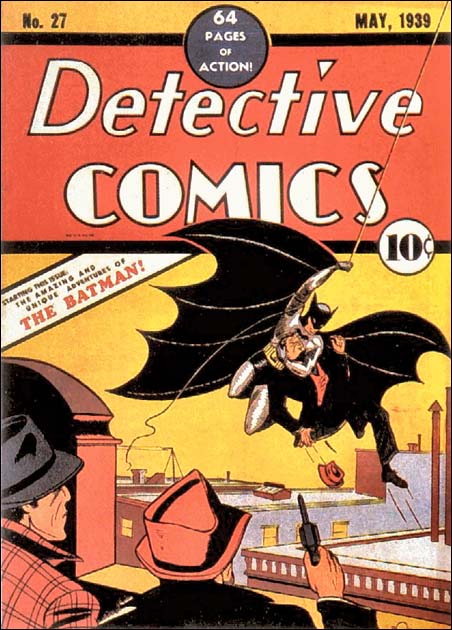
Detective Comics #27 (May 1939) by Bob Kane
You can really go back to the dawn of the golden age of comics and find the motif of a hero arriving via a rope. Heck that is how Batman made his first appearance on the cover for Detective Comics #27. Such use of a rope is a natural for any hero who lacks the power of flight. Of course this sort of transportation can only have a restricted use. It would really be stretching the limits of believability for a hero to travel great distances like a city version of Tarzan. Some early heroes overcome that difficulty by having a gun that could shoot out the wire to swing on. That has always seemed a rather crude technique. It was only years later that Steve Ditko would give Spiderman a more elegant solution to this problem.

Mystery Men Comics #11 (June 1940) by Joe Simon
Even looking for a more immediate influence on Jack Kirby will take us pretty much into the early part of the golden age. Joe Simon’s cover to Mystery Men #11 was done while he was editor at Fox Comics. At that same time Kirby was also there doing the Blue Beetle syndication strip. Joe’s cover has the Blue Beetle using a rope or wire for moving between buildings. Our hero has exited one building just in time to avoid an adversary. However his destination seems if anything even more perilously filled with enemies. I presume the Blue Beetle is using something like a telephone wire that connects the two buildings, that may seem more realistic then a rope that just happens to be conveniently available. Unfortunately it does make it harder to understand how the hero manages to use the wire. With one arm being used to both hold the swooning woman and fire a gun, the Blue Beetle has only one arm to move along the support. It would seem a rather daunting challenge, but then again that what heroes are for.
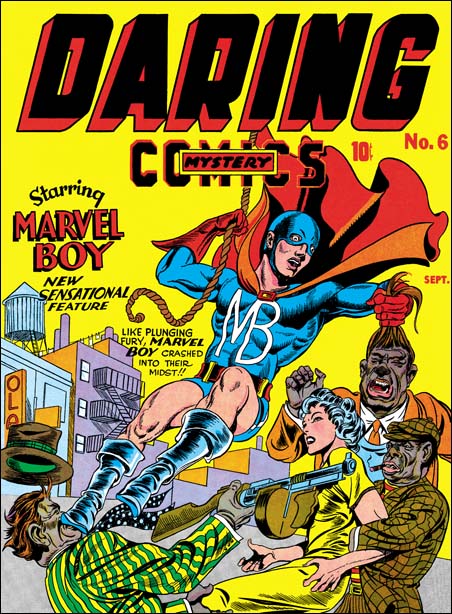
Daring Mystery #6 (September 1940) by Jack Kirby
I presume Jack Kirby liked the idea of the hero using a rope or wire to aid transportation. But he may have been uncomfortable with Joe’s solution of a wire already attached to the source and destination. Certainly rope swinging was both faster and more dramatic then going hand over hand. I believe that the cover for Daring Mystery #6 might have been Jack’s first use of a rope swinging hero.
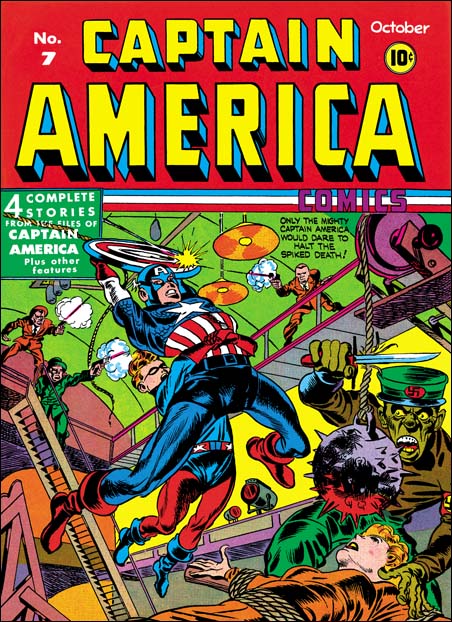
Captain America Comics #7 (October 1941) by Jack Kirby
Not that terribly long after Daring Mystery #6 Jack would return to a swinging hero with the cover of Captain America #7. But what a difference a year can make. Cap’s pose, with his arched body and legs spread wide, is a little surprising but there is no denying the rope swinging brings high drama to the cover. Since Cap is taking his sidekick along and not some “helpless female” the hero’s hands are both free to hold the rope while Bucky clings in turn to Cap. Captain America does have one problem that heroes like Batman and Marvel Boy did not share. Generally Cap makes great use of his shield for things such as protection against bullets. Here with rope swinging it just seems to get in the way.
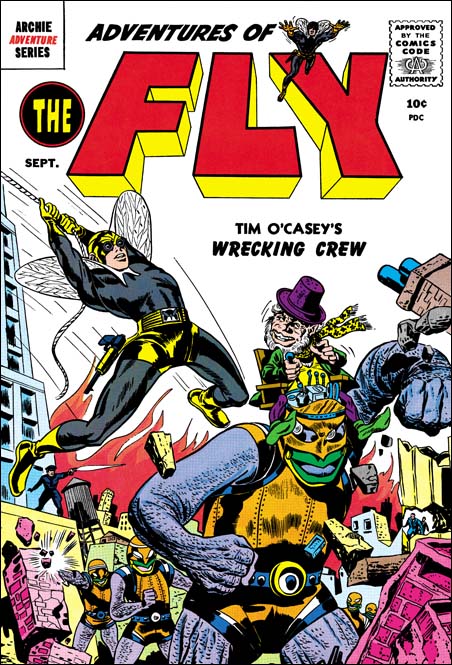
Adventures of the Fly #2 (September 1959) by Joe Simon and another?
I do not think that Kirby used rope swinging that often but it was one of his “tools” that he would pull out and use from time to time. It is hard to be sure about what Joe Simon may have brought to the creation of a particular Simon and Kirby piece. Did Joe provide layouts for the cover for Captain America #7? I will not suggest an answer to that question here. I will say that Joe seems very attached to Captain America’s pose for that cover. It turns up again years later in the cover for Adventures of the Fly #2. Some have attributed this cover to Jack but I am certain that the figure of the Fly was actually done by Joe.
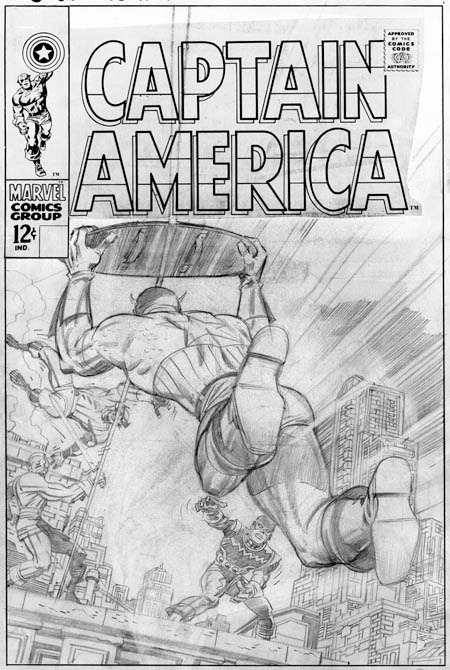
Unused pencils for Captain America #105 by Jack Kirby and Jim Steranko
I am sure that most, no make that all, of my readers know that Jack Kirby would return to drawing Captain America this time collaborating with Stan Lee. Jack would do some exciting covers for Marvel Comics. Sometimes Stan, as the editor, would request changes to a cover. Perhaps because I am such a Kirby fanboy, I generally do not understand what Stan found so objectionable. This was the fate for Kirby’s pencils for Captain America #105 cover . I will discuss what was done to the pencil version and by whom below. First let us discuss Jack’s return to the rope motif.
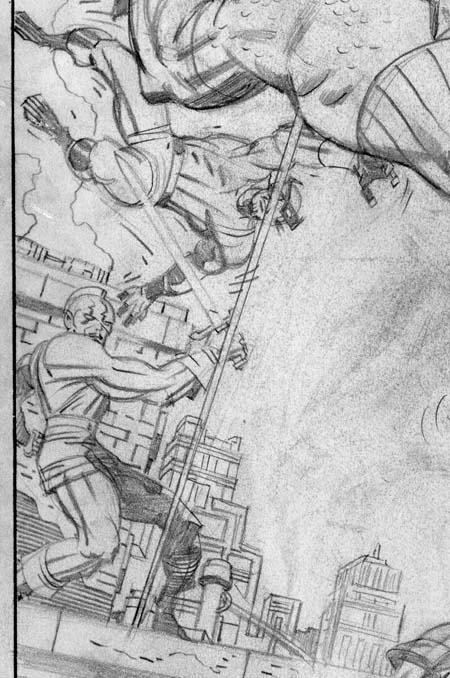
Unused pencils for Captain America #105 Batroc and the Swordsman by Jack Kirby
Yes Jack has once again has the hero travel via a rope but it is not by means of swinging. Instead Kirby has returned to using an attached rope essentially like Joe Simon had used for Mystery Men #11 so many years previously. However Kirby overcame both the awkward questions of how to travel on such a rope and what to do with Cap’s shield. No longer is the shield an impediment but is now the means by which Cap can quickly slide along the rope! This is one of the solutions that only seems obvious once it has been done.
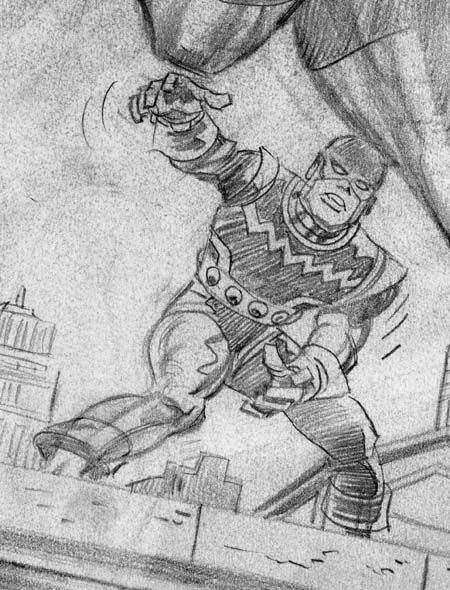
Unused pencils for Captain America #105 The Living Laser by Jack Kirby
This was one of those cases mentioned above, where Stan had some problems with Jack’s take on the Cap #105 cover. The good news is that this led to Jack’s pencils never being inked. The bad news is the pencil version of the cover as it exists today is not all by Kirby. Basically everything other then the figure of Captain America is pure Kirby, untouched by any other hand.
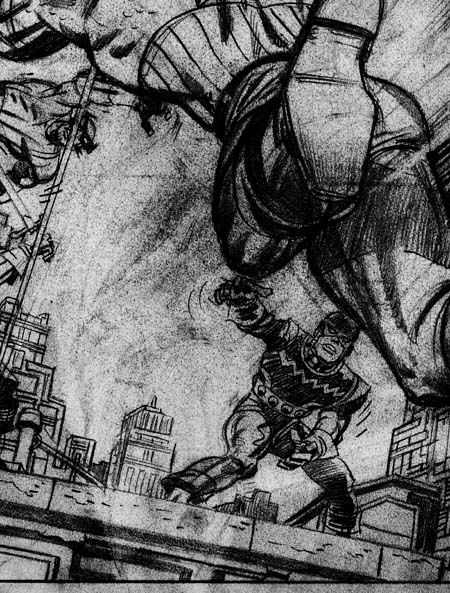
Unused pencils for Captain America #105 by Jack Kirby and Jim Steranko with Photoshop adjustments
Cap was modified both by penciling over what was already there, as well as erasing some of Jack’s pencils and adding new ones. Unfortunately there really is nothing that can be done to restore the pencils to the way Jack did it. Instead I have adjusted the scan using Photoshop. While this causes most of the image to deteriorate it helps brings out parts of the drawing that had been erased. Unfortunately it may still be hard to make out but it is the best that I can do. The important point is that Cap’s left leg was flexed and occupied the section that on the pencil version is now open sky.
When Stan was dissatisfied with Kirby efforts on this cover he turned to Jim Steranko to make corrections. Now I am a great admirer of Steranko. Even so I still shudder every time I think of Jim erasing Kirby’s pencils. After removing Jack’s version of Cap’s left leg Jim added his own. Presumable to make the whole figure uniform and to make some small adjustments, Steranko also penciled over the rest of the figure. Although I said the background was pure Kirby when Jim re-positioned the leg an area of the building previously covered by that leg had to be added. Jim kept to Jack’s type of architecture. The only difference that can be detected is that Jim’s pencils are slightly lighter then those by Jack. It is Steranko’s alterations to Kirby’s cover that is the state of the pencil version that exists today.
Lee still was not happy with the Kirby/Steranko version of the cover. But now things get complicated. There exists two rough sketches on tracing paper. Someone has written in blue pencil the names John Romita on one and Dan Adkins on the other. Which came first? To decide this I used Occam’s razor, “all things being equal, the simplest solution is the best one”. The paper used was chosen because it would allow desired portions to be traced. The order I provide here gives the fewest changes to each step keeping particular attention to what tracing was done. Without any claim that this is absolutely correct, I am fairly confident in the sequence I provide here.

Captain America #105 rough on tracing paper by Dan Adkins?
The Adkins sketch is the most rough one. So much so that I suspect we are just going to have to take the attribution on faith alone. Adkins has redrawn Captain America, swinging his legs around so that they are away from the viewer. In doing so, Adkins has shifted the center of the image to our left. Although done very crudely, the Swordsman, the Living Laser and the building the stand on were traced as one piece. Batroc was also probably traced but so roughly that it is hard to be certain. In any case Batroc’s position was shifted up and toward our left relative to his two companions.
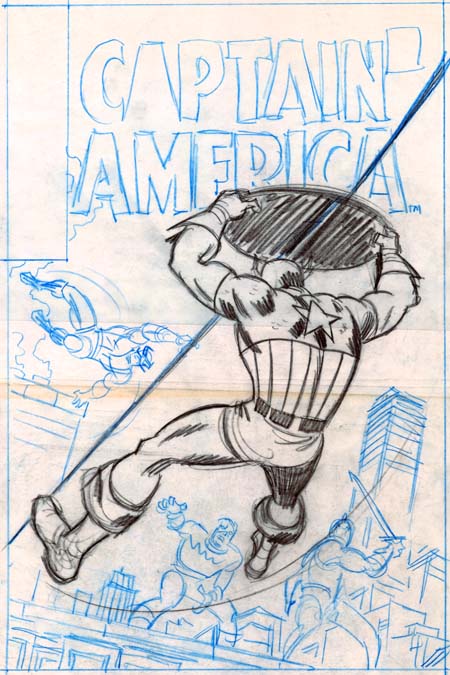
Captain America #105 rough on tracing paper by John Romita?
Now John Romita (senior) worked on it. Romita traced in regular pencil Cap’s torso from Adkins. He followed Adkins closely for the left elbow, the left side of the left forearm, the left side of the torso, the upper right shoulder area, the belt, the shorts and the right thigh. The upper edge of the shield is pretty close to Adkins placement. Romita lowered Cap’s left leg, moved the right lower leg to the right, and moved Cap’s right forearm out a bit. As can be seen, Romita tightened up the entire figure. (Here I must confess that I have not closely studied Romita’s work so I am counting on the silver age scholars among my readers to express their opinion on whether this attribution to John Romita is accurate.) Captain America is pretty close to the published version. With Cap’s new pose, clearly something had to be done about the background. Using blue pencil Romita has traced portions of Kirby’s architecture but shifting their locations. John did redraw the tall building on the right making it more angular relative to the horizon. Cap’s foes have also been trace from Kirby’s pencils. Batroc was moved a little bit higher then even Adkin’s placement. Romita switched the relative locations of the Swordsman and the Living Laser. I suspect that was done because he felt that the Swordsman would otherwise be too crowded. Batroc and the Living Laser adhere pretty close to Kirby’s pencil. The upper half of the Swordsman was traced while the pose for the lower body was altered.
At this point work must have begun on regular Strathmore paper, I am sure they would not want to end up inking on tracing paper. But further alterations were made from Romita’s rough. As I said previously the figure of Cap on the finished cover is pretty close to Romita’s drawing. The main differences are that both lower legs were made a little longer and the forearms placed a little further out. The lower rope follows both Dan’s and John’s path closely. But the upper portion is more faithful to Dan’s, leaving at the same place on Cap’s shield but angling a little more sharply. The rest of the background was rearrange once again, using Kirby’s pencils to trace from. Batroc’s position shifted down compared to Romita’s placement and his final placement is closest to that indicated by Adkins. The Swordsman and the Living Laser switch positions once again.
In the end on the published cover the buildings details follow Kirby, Cap’s foes are close traces from Jack, Cap himself is close to Romita’s drawing, and the overall background compositions is closest (but by no means matches) Adkins’ sketch. Of course the whole idea of using the shield to slide down a rope was Kirby’s. The Jack Kirby Checklist attributes the Cap #105 cover to “Kirby/Romita/Adkins” which sounds like an accurate description to me.
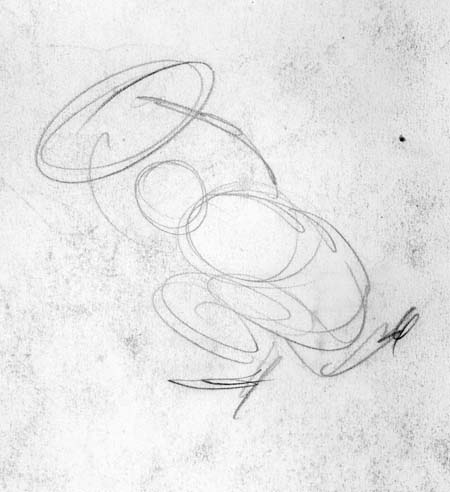
Sketch on back of pencils for the cover for Captain America #105 by unidentified artist
If that was not complicated enough, on the back of the Kirby/Steranko pencils is a small sketch. What part did it play in creation of the cover for Cap #105? I do not have a clue, but I will say I do not believe that this was done by Jack. I have never seen any evidence of Jack using crude sketches such as this one. Even in some work stopped at the very early stages Kirby had better placed lines and none of this pencil swirling.

Marvel Super Action #7 (April 1978) by Mike Zeck
But that still is not the end of the story. Years later Mike Zeck did the cover for Marvel Super Action #7. Is it a homage to Kirby/Romita/Adkins or a swipe? You can make your own decision. What do I think? I think I have written a long enough post as it is.


Harry,
Thanks for a very interesting post. I’ve seen the original art up close and it bothers me as much as you that those changes were made to Kirby’s pencils. As far as the sketches go, I’m not convinced the first one is by Dan Adkins (not Atkins); it looks like a Romita rough sketch, but the blue line drawing I would clearly identify as Romita. Perhaps Adkins name was on the sketch because he inked the cover and needed the reference? Whatever the case I would agree that the cover identification of Kirby/Romita/Adkins is correct.
BTW, where did you get the attribution for the Marvel Super action cover? I’m not sure if that is the work of Mike Zeck.
Nick,
I’m going to keep with the attribution penciled on the tracing paper. I really do not believe that such rough art by itself can provide a means of identification. As for your suggestion that perhaps Adkins was just the inker and needed the reference I do not see why getting your name on a rough sketch that nobody actually saw would help much. It does seem likely that Adkins was the inker but he probably also did the tracing used to construct the final cover, I cannot imagine Romita spending the time for such a task.
As for the Mike Zeck attribution I got it from a checklist from http://www.mikezeck.com. From the introduction of the checklist it would seem that Mike made up the list himself. I guess that he could be wrong but until someone can come up with a convincing argument otherwise I stick with Zeck.
Harry
This post had me take out my copy of Cap # 105 and take a look at the interior. Interestingly, on page 8, panel 4, the figure of Cap is noticably altered by someone other than Kirby, and it is an image of Cap swinging on a rope with his shield to meet his foes, the image that inspired the cover! It’s obvious that Cap’s right arm is changed, and it appears his foot and part of his leg is added as well. Very odd, indeed!
Nick,
Yep, looks like they could not leave Kirby’s interior version alone either. It is also interesting that all three interior panels shows Cap going feet first, but for the cover Jack chose feet last.
Harry
“Sou fã dos Desenhos do grande mestre JACK KIRB, aprendi a desenhar vendo os gibis MARVEL & DC, estou feliz em estar postando meus comentários nesta página!”